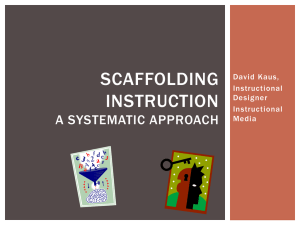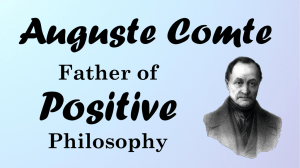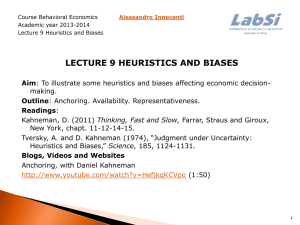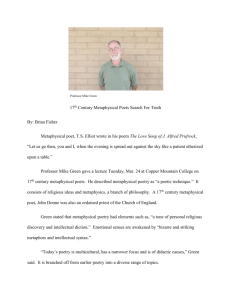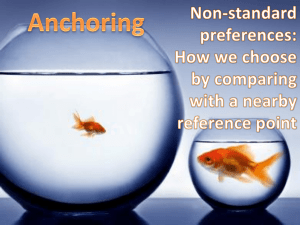Verbs and Minds
advertisement
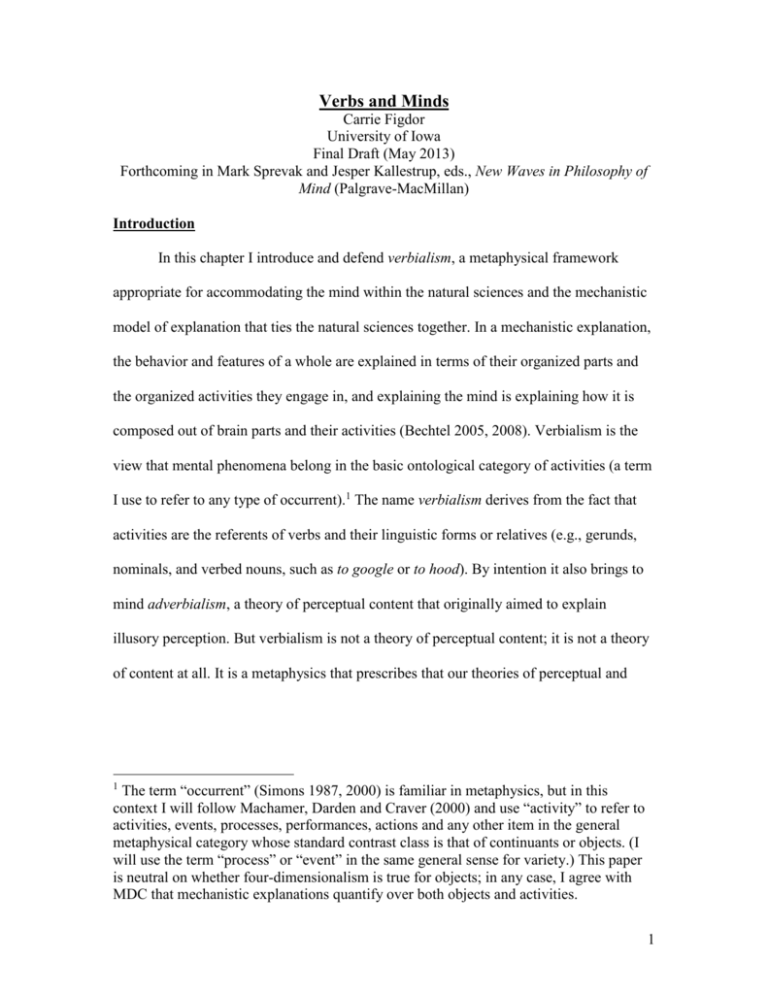
Verbs and Minds Carrie Figdor University of Iowa Final Draft (May 2013) Forthcoming in Mark Sprevak and Jesper Kallestrup, eds., New Waves in Philosophy of Mind (Palgrave-MacMillan) Introduction In this chapter I introduce and defend verbialism, a metaphysical framework appropriate for accommodating the mind within the natural sciences and the mechanistic model of explanation that ties the natural sciences together. In a mechanistic explanation, the behavior and features of a whole are explained in terms of their organized parts and the organized activities they engage in, and explaining the mind is explaining how it is composed out of brain parts and their activities (Bechtel 2005, 2008). Verbialism is the view that mental phenomena belong in the basic ontological category of activities (a term I use to refer to any type of occurrent).1 The name verbialism derives from the fact that activities are the referents of verbs and their linguistic forms or relatives (e.g., gerunds, nominals, and verbed nouns, such as to google or to hood). By intention it also brings to mind adverbialism, a theory of perceptual content that originally aimed to explain illusory perception. But verbialism is not a theory of perceptual content; it is not a theory of content at all. It is a metaphysics that prescribes that our theories of perceptual and The term “occurrent” (Simons 1987, 2000) is familiar in metaphysics, but in this context I will follow Machamer, Darden and Craver (2000) and use “activity” to refer to activities, events, processes, performances, actions and any other item in the general metaphysical category whose standard contrast class is that of continuants or objects. (I will use the term “process” or “event” in the same general sense for variety.) This paper is neutral on whether four-dimensionalism is true for objects; in any case, I agree with MDC that mechanistic explanations quantify over both objects and activities. 1 1 cognitive content alike be consistent with the fact that mental phenomena are activities.2 If minds are what brains do, explaining the mind is explaining how it occurs (Anderson 2007), and the ontology of mind is verbialist. At least, it ought to be. Here I motivate verbialism by revealing a kind of inattentional blindness philosophers of mind have shown when it comes to conceiving of their explanandum as a kind of complex activity. I will also show how the project of naturalizing the mind is altered when we correct for this inattention. By “naturalizing” the mind, I mean providing an explanation of mental phenomena that does not involve supernatural elements or interventions and that ties the mind with some degree of modal strength to the physical world and its laws, entities and activities.3 But I also distinguish two distinct tasks within the project of naturalization. One is to explain content using only naturalistic ingredients (e.g., Dretske 1988, 1995); another is to articulate the ontological scaffolding under any naturalistic theory of content (and consciousness, if it is not already accounted for within the semantic task). The semantic task has been treated as the only task once physicalism of some sort is accepted. But physicalism in general has The term “state” does not denote a stable ontological category (Steward 1997; Marcus 2006, 2009). But while it has a connotation of “unchanging” or “undynamic”, it is used in the sciences to denote equilibria, which require maintenance in open systems, or idealized momentary time-slices of dynamic phenomena. I will use “state” when customary usage demands it, but only as an ontologically neutral term equivalent to “phenomenon”. 3 The language here is intended to be neutral among all views which attempt to naturalize the mind by linking the mental to the physical with some degree of modal strength. What is ruled out is any view in which the mind has no necessary connection of any sort to the physical. I define non-reductive physicalism as the denial of reductive physicalism (which I identify with the Identity Theory), and consider property dualism, like functionalism, a special case of non-reductive physicalism. On the main functionalist views, mental states are either identical to physical states which happen to be picked out by functional-role descriptions, or are identical to the functional-roles picked out by the functional-role descriptions (and, in accordance with physicalism, are realized by physical states). 2 2 not been fully articulated in a critical sense, to the detriment of our theories of content; the metaphysical task is to complete the job. In the first section, I show how neglecting the metaphysical task has hampered theorizing about the mind. In the second section, I show how the verbialist answer alters our approach to the semantic task. In the third section, I sketch a method for addressing the semantic task within the verbialist framework. Part I. Inattentional Blindness in Philosophizing About the Mind To clarify what the metaphysical task involves, consider Descartes’ answer to it. He classified the mind in the ontological category of particular substance or thing. This answer does not preclude physicalism: to say the mind is a substance is not to say it is distinct from physical phenomena of any ontological category. Rejecting substance dualism can mean rejecting the relation to the physical it asserts or the ontological category to which it assigns the mind. An activity dualist would reject only the second disjunct, saying that Descartes made this kind of category mistake, not the other one. Physicalists reject both disjuncts. The type-type identity theory, for example, does not identify the mind with the brain or neurons (nor with an abstract object; I take this for granted in what follows). The contemporary ontological picture is one in which there are physical objects and mental and physical properties and relations corresponding to nplace mental or physical predicates true of these objects; physicalism then asserts a modal relation between the kinds of properties or relations. In this picture, anything that is not a particular object becomes a property of one or relation between at least two objects. This impoverished ontology is not entailed by the formalism of modern logic, but rather stems 3 from a philosophical tradition of ontological parsimony coupled with an object bias. Being heavy, being blue, rotating, and diffusing through a membrane are treated equally as properties of objects even though, as Davidson (1967, 1970) argued, activities have just as much call to be concrete particulars as the objects that engage in them (see also Machamer, Darden and Craver 2000). I defend this particularist position for activities elsewhere based on metaphysical and scientific considerations.4 The important point here is that when we reject the substance category for the mind, our metaphysical work is not done. Ryle (1949) ridiculed Descartes for characterizing the mind as not-physical substance. But merely characterizing the mind as physical not-substance is equally inadequate. To see one result, consider pain experiences. Such experiences strike us naturally as both monadic (non-relational) and as activities – as nominalizations of to experience, an activity we engage in on our own. Empirical facts aside, the stock example of the Identity Theory – “pain = c-fibers firing” – posits an object (c-fiber) engaging in an activity (firing). But a c-fiber is not a mental kind of object, and firing is not a mental kind of activity. So the theory must also claim that this kind of object engaging in this kind of activity in this way, or that this kind of activity done by this kind of object in this way, yield a token of a mental kind – pain-experiencing.5 Either way, it is easy to discern two independent dimensions to the multiple realization objection to the theory. First, can other entities besides c-fibers realize pain-experiencing? Second, can other activities 4 Thus, my defense of verbialism is only partial in this paper. The whole position claims that (a) minds are complex activities and (b) activities are concrete (non-abstract) particulars. Here I defend only (a). One might equally distinguish weak and strong forms of verbialism, depending on whether one supports (a) or both (a) and (b). 5 If all the world is states of affairs (Armstrong), then mental phenomena will also be states of affairs. But these include activities as components. 4 besides firing realize pain-experiencing? Only the first question has gotten much attention. But for even this most straightforward of physicalist theories, we need to ask not just about the kinds of entities but also the kinds of activities that realize the mind. This attention deficit has theoretically damaging results beyond mere neglect when we consider the received view of propositional attitudes, which are often stand-ins for any cognitive state. They are relations to mental representations, which in turn are symbols with content. This ontology is also used to elaborate the computational idea of cognition as information-processing. But while in theory the symbols can belong to any ontological category, a popular metaphor describes the package in terms of items that are put in boxes, itself an object metaphor for roles in a cognitive economy. The same mental symbol put in one box (moved around in one way) is a belief and put in another box (moved in another way) a desire. Note how odd it sounds to conceive of pain experiences in terms of an object with a pain property that is put in an experience box. The reason this model in fact requires object-like symbols is because it becomes non-explanatory when we try to articulate it in terms of mental symbols as activities – as mental-representings. The model entails that attitudes and propositions are independently individuated; the point of holding a relational view of the attitudes, after all, is that these elements can be freely recombined without changing their identity qua attitude or proposition. But a relational view requires relata, and if mental symbols are not objects then we need particular activities as relata that are manipulated (e.g., believed, desired and so on for each role in one’s mental economy). But to manipulate an activity is to modify it –to change how, when, or where it occurs – and these changes are typically type-relevant. For example, modifying the flow of water by opening or closing a valve, or 5 by changing the temperature, results at the very least in a distinct species (or determinate) of flowing from what was occurring before. These differences are marked in language in ways that include but are not limited to adverbial modifiers. So if attitudes are activities – e.g., if believing is a complex doing – and mental symbols are also activities, then the attitude/propositional-attitude relation is not adequately seen as involving independently recombinable elements. Assuming that manipulating an activity doesn’t invariably yield a different kind of occurrent altogether – that is, assuming activity kinds are sufficiently robust to allow for some continuity through change – the relation plausibly is, or often is, one of genera/species (or determinable/determinate), such that individuating the attitude is necessarily part of individuating the propositional-attitude.6 Thus, one can have a relational view of the attitudes if mental symbols are object-like, or a non-relational view if they are activities. But what one cannot do is pretend that a relational view of the attitudes is neutral regarding the ontological category of mental representations.7 Standard naturalistic theories of content do treat mental symbols as object-like – they assume the continuity of type through change that is normal for objects but not for activities. The vehicles of content are often described as neural firing patterns that occur, in easy cases and initially spontaneously, in response to real external objects or states-ofaffairs. But when the firing pattern is embedded in a circuit of internal activities leading 6 For clarity of discussion, here I will take the species/genera or determinable/determinate relations as common relationships between activity types (including mental activities). 7 A standard argument against a monadic view of the attitudes is that a relational view is required if natural languages have compositional truth-theoretic semantics (Schiffer 1987), such that certain acceptable inferences come out valid (A and D both believe that P; therefore there is something they both believe). Thus, ‘believes’ maintains its semantic value in ‘believes that P’ and ‘believes that Q’. The verbialist ontological (and adverbial semantic) response is that the relation does differ, but that if A and D both believe that P, therefore there is indeed something they both do: namely, believe that P. 6 to behavior, the new connections to other activities cannot alter the firing pattern’s response profile to external objects in any type-relevant way. The semantic theory must maintain that the result of embedding an activity into other activities makes no semantic difference: once an O-indicator, always an O-indicator. This presumed independence of spontaneous-indication activity type from indication-in-a-control-circuit activity type makes it possible to derive the semantic value assigned to the latter from the indication value assigned to the former. This is plausible if one thinks of firing patterns as objectlike in terms of their persistence through change, but it is highly unlikely if one takes seriously their nature as activities: changing the circumstances in which an activity occurs typically affects how it occurs, and such changes often affect its type at least by changing its species. What is missing is any justification of the implicit assumption that these likely differences in indication activity type make no semantic difference. Theorizing about the attitudes themselves, as functional roles, has also suffered due to inattention to the metaphysical task. Functional individuation is individuation in terms of activities, given that a functional role just is a complex of activities. This idea is invariably illustrated with object artifacts and often involves emphasizing the difference between what something does and what it is made of. But the theory and the explanation of the theory are obviously inadequate when we consider how to apply it to activities. For one thing, it merely raises the question of how activity kinds are individuated in the first place. Moreover, an activity just is what it does – it is not ‘made of’ anything in any usual sense. So if this stock distinction is to make any sense, it must be translated into the claim that the fundamental kind to which a token activity belongs changes once it plays a role in a system of activities. For example, the theory of functional individuation entails that a 7 token of transmitting is one basic kind of activity when done in one context and another when done in another. This again gets the individuation of activities wrong, but from the other direction: in many cases activities do remain tokens of the same general type but are further specified by each context. A mousetrap made of wood is not a species of wood, but neurotransmission is a species of transmission. Activities do play roles in systems and do have functional-role descriptions, but they typically play the roles they do in virtue of the general kind of activity they already are, and remain, even if their species changes. If this were not so, embedding an O-indicating neural activity pattern into a new circuit of activities would entail that one would not have an O-indicator anymore. Much to their credit, adverbialists did reject the act-object model -- and hence an objectlike-object model -- at least for perceptual states. To explain non-veridical perception, a felt need for an intentional object led to the positing of sense data to serve as relata of a mental act given the absence of real external objects. The term “object” here again does double duty: an intentional object is a target of an intentional act, but the rejection of the act-object model was also motivated by the idea that these intentional objects were weird objects in an ontological sense. To get rid of them, adverbialists claimed that there was act(ivity) and modifications of act(ivity), not act(ivity) and objects. As usually interpreted, they claimed that to experience was an intransitive rather than a transitive verb: one experiences-in-a-certain-way (e.g., hallucinates-orangely) just as a top rotates-in-a-certain-way (e.g., rotates-wobblingly). They may have been wrong in specifics, but their enduring ontological insight was the idea that content is not a property of objects but of activities. They interpreted Brentano’s mark of the mental as contentmodification of activity kinds. Crudely put, brains (or parts of them) engage in mental- 8 representing or -experiencing just as c-fibers engage in firing. Eliminating sense-data entailed an alternative ontological framework that practically precluded conceiving of the activities as object-like. Unfortunately, the main argument against adverbialism – that it could not explain the fine-grained structure of content, in particular propositional content – failed to engage this ontological insight. To borrow Kriegel’s (2012) example, if “I am thinking of a green dragon and a purple butterfly” is paraphrased adverbially as “I am thinking green-dragonwise and purple-butterfly-wise”, one could not infer from “I am thinking green-dragonwise” to “I am thinking dragon-wise” any more than one could infer from “I am thinking catalog-wise” to “I am thinking cat-wise”. But natural language expressions of valid inferences do not entail that the mental states expressed are structured in just that manner. Different possible paraphrases may reflect different ways in which the same inferences can be implemented by a cognitive system, or may not provide any clue as to how they are implemented. In effect, the objection ignores the verbialism underlying adverbialism. Activities come in kinds and are organized in hierarchies. On the adverbial view, some of the specific ways of doing activities we call “content”. So if the relation between thinking green-dragon-wise and thinking dragon-wise is genera/species (or, as Kriegel also suggests, determinate/determinable), we have activities that are modified in specific ways. There is much we don’t know about the individuation of activities, but it is no objection to assert that no method of individuating them is sufficiently fine-grained for content. One final area worth noting that has been negatively affected by inattention to activities is the contemporary debate about disjunctivism. Disjunctivism claims that veridical and non-veridical perception are distinct kinds of mental states; on an adverbial 9 view, they are distinct content-modified kinds of activities (e.g., hearing-trumpetly and hallucinating-trumpetly). But the critical issue is whether the difference between veridical and non-veridical perception entails a difference in activity kind at the level of type individuation of interest. Without specifying a level, disjunctivism is ill-defined and the debate about it has no clear point of contention. Part II. Distinguishing (Verbial) Metaphysics from (Adverbial) Semantics Verbialism says mental kinds – pains, perceptions and propositional attitudes alike – are activity kinds. Adverbialism got the basic ontology right but did not sufficiently distinguish its implicit answer to the metaphysical task from the semantic task. Its ontology directed us to explore the individuation of activity kinds, the nature of complex activities, and their taxonomic hierarchies. These are the general theoretical questions of which content-modifications of activity kinds, the classification of some activity kinds as mental, and the relation between mental activities, such as perceivingveridically and perceiving-non-veridically, are specific cases. For whatever reason, we did not take the hint.8 If naturalistic theories of cognitive content had started trying to explain green-dragon thoughts, more philosophers might have questioned the standard relational model of the attitudes and its implicit ontology. Instead, they focus on types of real physical objects – e.g., cats, rather than dogs or mammals or undetached-cat-parts or cats-or-dogs – that are the relata of unspecified 8 However, the tide is changing. For example, Kriegel (op. cit.) extends adverbialism to all conscious mental states, and Crane (2011) indicates that the failure of existential generalization for cognitive states (How do we explain how A is thinking about P even though we cannot infer from this that there is, in physical reality, something A is thinking about?) and the problem of intentional inexistence for perceptual states both motivate adverbial explanations of mental representation. 10 “causal relations”. But verbialism insists where adverbialism only hinted. If we want to explain the mind naturalistically, we need to think about the nature of activities. This is a far broader project than can be pursued here, but I can indicate two ways in which it will affect how we think about the semantic task. First, different kinds of activities have different occurrence conditions. Some are such that entities can engage in them independently of anything else, although they may require triggering by an external item to occur. Rotating is not the general kind of activity it is in virtue of the existence of anything other than the rotater. Others, such as hitting, cannot occur without two objects (although one relatum can be a part of the other). Yet others, such as hurricanes, are not performed by objects (are “unowned”) at all, and are related to them in some other way. These distinct occurrence conditions are distinguished in ordinary language when verbs are used transitively (direct object: The farmer smells the rotten corn), intransitively (no direct object: The rotten corn smells) or in a linking manner (subject complement: The corn smells fresh). The same verbs can be used to pick out activities with different occurrence conditions on different occasions of use. These different occurrence conditions entail that the ontological category of activities cross-cuts the available categories of first-order predicate logic (variable and nplace predicate, usually taken to range over objects and properties/relations respectively). This logical diaspora does not entail that the ontological category is illegitimate (and the fact that we do not use predicates like “is-pegasizing” shows that the ontological category of object is implicitly legitimate). To the contrary, in the sciences, and in mechanistic explanation in particular, the category usefully groups phenomena that play explanatory 11 roles at least as essential as those of objects. This justifies favoring unity of explanatory role over unity of formal logical role, especially for the purpose of naturalization. Verbialism does not restrict the types of occurrence conditions that mental activity kinds may involve. For example, think may not have one kind of occurrence condition, and perceive or experience may pick out activities like rotate or hit depending on context.9 It does claim that general kinds of activities (e.g., perceiving) can be modified in various cognitively relevant ways, which adverbialists posited as special cases of general kinds (e.g., perceiving-redly). These content-modified special cases may involve implicit or explicit reference to external objects if the general kind allows them (e.g., thinking) or requires them (seeing, used transitively) but not if the general kind precludes them (e.g., hallucinating). This occurrence-condition neutrality of verbialism explains why it is consistent with adverbialism that being appeared-to F-ly could be a way of representing that something is F (Siegel 2013; although the adverbialist would call it a way of representing-F-ly). If content is accuracy conditions, where to be accurate is to correctly represent some aspect of the external world, there is no reason why adverbial content might not be determined by causal relations to external objects: for from the verbialist perspective it depends on the nature of the general activity kinds and how they are modified. For the same reason, verbialism is neutral regarding disjunctivism, semantic internalism and externalism, and the bounds of cognition. From this perspective, the debate between the two dominant views of perception – the relational view or naïve realism, in which to perceive is to stand in a primitive relation of awareness or acquaintance with the world, and the representational or content view, in which to perceive is to represent the world in a certain way (Campbell 2002) – may rest on distinct, equally legitimate, ways of using the same verb to pick out different activities. I must set aside here the important questions of whether mental activity kinds are natural kinds, and which, if any, are natural kinds. 9 12 Second, verbialism directs us to examine which modifications of general activities yield contentful special cases – that is, the mental activity kinds we call perceiving-redly, thinking-green-dragon-wise, and so on. This is also not the place for a theory of contentmodifications – an adverbial theory – although I suggest how we might develop one in the next section. But I will note a fruitful new way of understanding what is required for successful naturalization. It is consistent with the naturalistic goal of explaining mental activities in terms of non-mental activities that a specific kind of activity may be essentially mental even while its general type is not. Moreover, some general kinds of mental activities (e.g., perceiving, recognizing, etc.) may be classified as mental not because the general kind is mental but because all cases we consider paradigmatic of that activity kind involve human-realized tokens of content-modified specific types. For example, we may understand perceiving by acquaintance with or inference from human performances associated with perceivingP-ly, but it does not follow that perceiving as a general kind is mental. Perceiving-P-ly may be the special, mental, case we get when a non-mental activity is modified in a particular way. For the same reason, propositional attitudes may be mental even if attitudes are not, given that the former are special cases of the latter. As a result, while a naturalistic explanation of mind may only avail itself of explanantia found in the material world, from a verbialist perspective it may do so by extending familiar mental concepts to what are usually considered non-mental domains. As a result, the question of whether an activity kind picked out by a mental concept is essentially mental, or whether a so-called mental concept is essentially mental, may have a negative answer. In the next section I will sketch how this might come about. 13 Part III. Doing Semantics Within a Verbial Framework Verbialism directs our attention to the question of how activities may be individuated as fine-grained as contentful mental states appear to be and which modifications are content-modifications. In this section I show how we can take advantage of some interesting features of activities to pursue the semantic task in a new way. I will use Kriegel’s (op. cit.) “anchoring instance” model of natural-kind conceptfixing to show how we might go about specifying content-modifications and thus what a theory of perceptual or cognitive content within a verbialist framework might look like.10 Kriegel’s original model is a resemblance-to-cluster-of-paradigms account. For example, we use anchoring instances of mammals, such as horses and cats, to fix the category mammal. We posit a common underlying nature that non-anchoring instances can be found to have and that some anchoring instances can be found not to have (and thus ejected from the category). Anchoring instances have a special epistemological status, not a special metaphysical status. Our goal may be a metaphysical category, but our method does not and need not ensure that we get the contours of the category correct right from the beginning. In scientific theory development, this is par for the course. This account fits not just the object-kind concepts Kriegel uses to illustrate the view, but also activity-kind concepts. Anchoring instances of activity kinds would 10 Kriegel argues for experiential intentionality (i.e., phenomenal states) as the basis for all intentionality by arguing that all anchoring instances of intentionality are of experiential intentionality. My use of his model is neutral on this issue. Also, since perceptual and cognitive states both may have experiential aspects, what distinguishes them is the kinds of content they are thought to have – although even here the distinction between perceptual content (e.g., of a visual percept) and cognitive content (e.g. of a belief) is no longer clear. It is in verbialism’s favor that it provides a unified ontological framework for both kinds of states. 14 include those of the sort exemplified by “See Spot run!”: Spot’s running is an anchoring instance of running, and our seeing Spot run is an anchoring instance of seeing. Similarly, a rotating top is an anchoring instance of rotating, and a person recognizing an object is an anchoring instance of recognizing. But just as the discovery that whales are mammals shows that the category was open to new non-anchoring instances, the discovery that alpha-helixes rotate shows that the concept of rotating was always open to its instances being done by alpha-helixes, even though these could not be anchoring instances. Importantly, the new uses can be literal. Whales are not prototypical mammals, but the term “mammal” is not used metaphorically when applied to whales. When we discovered rotating alpha-helix chains in neural cell membranes, the term “rotating” is not used metaphorically. In both cases the terms are found to have wider-than-initiallyrealized domains. With mammal, we find that the category includes new species. With rotation, we find that the same activity is performed by different kinds of entities. The extension also opens up the possibility of individuating a subordinate level of the activity kind – e.g., a species of rotating individuated in part by a kind of entity that performs it. For some specific activity kinds – neurotransmission, batting – do involve explicit or implicit reference to object-kinds in their individuation, even if the general kind does not. It follows that part-whole (or micro-macro) relations do not determine basicness for activities even if it does for objects. Otherwise put, the fact that a kind of activity appears in an explanation in a particular science does not make it essentially of that science. There may well be a periodic table of activities, but what appears in the table is not determined by the kinds of objects that perform them. Vibrating is vibrating whether it’s done by an atomic nucleus or a piano string. Even if electron-bonding is a special 15 case of bonding performed by entities in basic physics, bonding simpliciter isn’t a basicphysical activity since many things bond that are not basic-physical entities. The explanation of how non-basic objects bond is a distinct issue; given that they do bond, the status of bonding simpliciter as basic or not is not determined by a science of one type of entity that does it. These general considerations about activities are relevant to any ontology of mind in which mental kinds are activity kinds. Many if not all anchoring instances of mental activities – perceiving, recognizing, etc. – are of these activities as they are performed in their content-specified human cases. But it does not follow that perceiving or recognizing are activities that only humans perform, even if it turns out (which it may not) that their content-modified species – the activities we pick out with propositional-attitude or other content-specified descriptions – are restricted to being performed by and ascribed to humans. In traditional terms, mental ascriptions can employ verbs that create intensional contexts but are not essentially mental. And even if all anchoring instances of a mental kind are conscious instances it doesn’t follow that being experienced consciously is essential to that kind of activity. Moreover, just because a new instance is not an anchoring instance does not mean that the use of the term for a new case must be metaphorical. When any activity we are acquainted with in everyday life – running, rotating, breaking, seeing, recognizing, experiencing, and so on – is found in a new domain, the uses of old terms to pick them out can be literal extensions to non-anchoring cases. Even if all anchoring instances of spinning or recognizing are tops spinning and people recognizing, alpha helixes can really spin and antibodies can really recognize, even if they may not recognize antigens 16 in the same specific way a person recognizes a friend or recognizes that she is being rude.11 We may classify an activity as mental, cognitive or psychological because the anchoring cases are those performed by human beings, but this does not entail that the general kind of activity is mental even if the special case is. An example might help clarify the above account. I will use the language of adverbialism and borrow an example from Kriegel (op. cit.). Suppose Emorie hallucinates a triangle. The adverbialist says Emorie is experiencing-trianglishly – in verbialist terms, doing-in-a-content-modifying-way.12 Her semantic account of Emorie’s experience might go this. First, she hypothesizes that Emorie’s experience is a token of a content-modified activity kind. For she does not name the token experience, she types it. Second, she relies on her knowledge of object kinds to invent a term to pick out this occurrence as a token of a hypothesized content-modification of the general activity of experiencing. She extends her object-kind concept of triangle from anchoring instances of triangles by adverbing the concept, such that experiencing-trianglishly is to triangles what googling (better: searching-googlishly) is to Google. This method not only makes her hypothesis intelligible; it also may be true. In a similar way, representing-catly or 11 Lakoff and Johnson (1980) claim that many folk explanations utilize a limited set of primitives, including activity primitives derived from bodily and cognitive activities. Their work is obviously relevant here, but I deny their assumption that the extensions are metaphorical. Scientific explanations and hypotheses obey similar intelligibility constraints, but the metaphysics of activities shows that they can also be literally true. 12 Although here I discuss only kinds or types, naturalization is often discussed in terms of tokens: Does a mental token fall under an F-ly representational type because it stands in a causal relation to F-things (to instantiations of F-ness)? On my view, it is one thing to individuate a kind or type and another to determine how a token may meet the conditions for falling under the type. (One can become an American citizen in more than one way.) Thus, what experiencing and experiencing-trumpetly are as kinds, and what it is for a token occurrence to be of the experiencing-trumpetly type, are separate issues. 17 experiencing-redly are content-modified species of activities individuated by relying on our knowledge (respectively) of cats or red things and adverbing the object-types. But there are many things her use of the new type label does not determine. She is not (yet) picking out an instance of experiencing-trianglishly because she does not know that this type occurs in our world. But suppose it does. It is still an open possibility that experiencing-redly is multiply realized by different activity kinds, or that experiencing simpliciter is multiply realized even if experiencing-redly is not. It is also possible that the activity type denoted by her hypothesis (in either the general or specific case) may be as constitutively dependent for its occurrence on external states of affairs as most cases of hitting. For her underlying verbialism leaves open whether experiencing-trianglishly is constitutively connected to external instantiations of triangularity, and if it is, how it is. As noted, being an anchoring case is an epistemic status, not a metaphysical one. Nonveridical and veridical experiencings-triangishly can share the epistemic fact that we pick them out with the same adverbed nouns without fixing the metaphysics either way. The adverbialist’s method is familiar throughout science when positing a new phenomenon, whether it be an object or an activity (or anything else). It does no metaphysical harm but it does plenty of epistemic good. If we do not already understand what a verb refers to, we can be shown an example. If we explain a piano’s vibrating partly in terms of a vibrating string, the string’s vibrating is literal and explanatory of the whole’s activity. It is a separate issue that neither explanandum nor explanans will be intelligible to someone who does not understand what vibrating is. If you know enough to ask the question, the answer is intelligible, and it also may be true. There is no failure of 18 explanation in either sense if it is true. But if you don’t know enough to ask the question, no explanatory failure of either type can arise. It follows that from a verbialist perspective naturalizing the mind is not constrained to show reduction to (or supervenience on) non-mental activity kinds. The assumption behind this constraint is that activity kinds are essentially individuated at a particular level of performers, such that when verbs that pick them out are used for new occurrences by other performers at other levels of material composition the uses are nonliteral. Call this assumption the Unique Literal Performers (ULP) thesis. If ULP is true, mental activities are performed literally only at one level of material complexity (humans, and maybe some other sufficiently complex animals) and that a naturalistic explanation of them requires us to replace or redescribe organism-level mental activity kinds in terms of non-mental kinds of activities literally performed by their parts.13 But there is no reason to think ULP is true for mental activities if it is false in general for activities. Mental activities are special, but this may be because human beings are special, not because the activities we associate with humans are unique to humans. Concluding Remarks Saying what the mind is not, as physicalists have done, does not suffice for a firm ontological framework for naturalization. We also need to say what it is. Verbialism provides this positive account. Moreover, once we pay attention to the nature of activities, we discover problems in our current theories of mind and new ways to approach the 13 For many philosophers of mind, ULP is the general principle behind the idea that in a mechanistic explanation of mind none of the decomposing elements individually can be identical to the whole they compose on pain of launching the explanatory regress (see, e.g., Lycan 1987 on homuncular functionalism). 19 semantic task. Verbialism leaves to further empirical and philosophical investigation many of the details of understanding activity kinds and mental activity kinds. But the success of this research depends on getting the basic metaphysics right. Bibliography Anderson, John R. (2007). How Can the Human Mind Occur in the Physical Universe? (Oxford and New York: Oxford University Press). Bechtel, W. (2005). "The Challenge of Characterizing Operations in the Mechanisms Underlying Behavior." J. of the Experimental Analysis of Behavior 84: 313-25. (2008). Mental Mechanisms. New York and Oxon, UK: Lawrence Erlbaum Associates, Taylor & Francis Group. Campbell, John (2002). Reference and Consciousness. Oxford: Clarendon Press. Crane, Tim (2011). "The Problem of Perception", in The Stanford Encyclopedia of Philosophy (Spring 2011 Edition), Edward N. Zalta (ed.), URL = <http://plato.stanford.edu/archives/spr2011/entries/perception-problem/>. Davidson, Donald (1967). “The Logical Form of Action Sentences”. In N. Rescher, ed., The Logic of Decision and Action (Pittsburgh: University of Pittsburgh Press). (1970). “Events as Particulars”. Nous 4 (1): 25-32. Dennett, Daniel C. (1978). Brainstorms. Cambridge, MA: The MIT Press. Dretske, F. (1988) Explaining Behavior. Cambridge, MA: MIT. (1995). Naturalizing the Mind. Cambridge, MA: MIT. Figdor, C. (MS). Making Physicalism Matter. Field, H. (1978) “Mental Representation”, Erkenntnis 13 no. 1, 9-61; reprinted in Block, ed., (1980) Readings in the Philosophy of Psychology Vol. 1 (Cambridge: Harvard University Press). Jackson, F. (1977) Perception: A Representative Theory. Cambridge: Cambridge University Press. Kriegel, U. (2007). “The Dispensability of (Merely) Intentional Objects.” Philosophical Studies 141: 79-95. (2012). The Sources of Intentionality. New York: Oxford University Press. 20 Lakoff, George and Mark Johnson (1980). Metaphors We Live By. Chicago and London: The University of Chicago Press. Levin, Beth (1993). English Verb Classes and Alternations. Chicago and London: The University of Chicago Press. Lycan, William G. (1987). Consciousness. Cambridge, MA: The MIT Press. Machamer, Peter (2004). “Activities and Causation: The Metaphysics and Epistemology of Mechanisms”. International Studies in the Philosophy of Science 18 (1): 27-39. Machamer, Peter, Lindley Darden and Carl F. Craver (2000). “Thinking About Mechanisms.” Philosophy of Science 67 (1): 1-25. Marcus, Eric (2006). “Events, Sortals and the Mind-Body Problem”. Synthese 150: 99129. (2009) “Why There are No Token States”. Journal of Philosophical Research 34: 215241. Ross, Don and David Spurrett (2004). “What to say to a skeptical metaphysician: A defense manual for cognitive and behavioral scientists”. Behavioral and Brain Sciences 27: 603-647. Ryle, Gilbert (1949). The Concept of Mind. (Chicago: University of Chicago Press). Schiffer, Stephen (1981). “Truth and the Theory of Content”, in Parret, H. and J. Bouveresse, eds., Meaning and Understanding (Berlin: Walter de Gruyter), 204222. Siegel, Susanna (2013). "The Contents of Perception", in The Stanford Encyclopedia of Philosophy (Spring 2013 Edition), Edward N. Zalta (ed.), URL = <http://plato.stanford.edu/archives/spr2013/entries/perception-contents/>. Simons, Peter J. (1987). Parts: A Study in Ontology. New York: Oxford University Press. (2000) “Continuants and Occurrents, I”. Aristotelian Society Supplementary Volume 74 (1):59–75. Smart, J.C.C. (1959). “Sensations and Brain Processes.” Philosophical Review 68: 14156. Steward, Helen (1997). The Ontology of Mind: Events, processes and states (Oxford: Oxford University Press). Van Gelder, T. (1995). “What Might Cognition Be, if Not Computation?” Journal of Philosophy 92 (7): 345-381. 21
